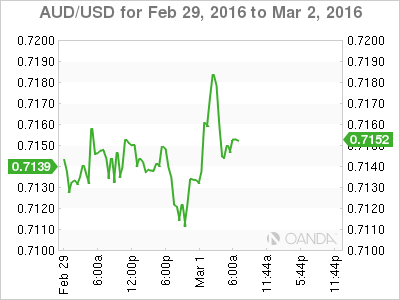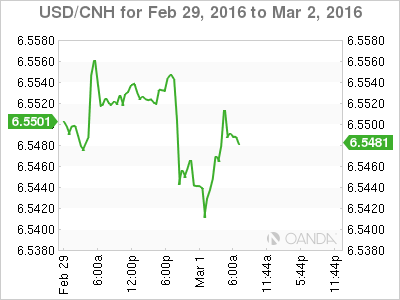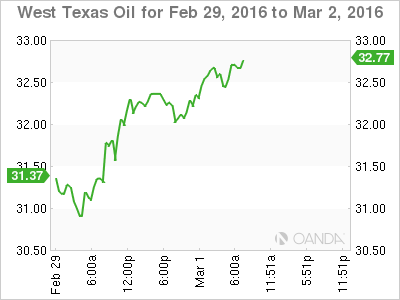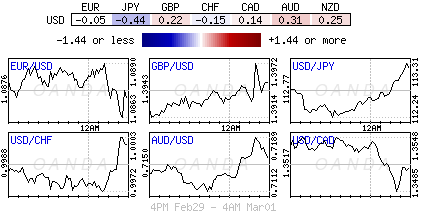Tuesday March 1: Five-things the markets are talking about
This is the first trading day of a new month. In U.S equities, March has a recent record of 14 up and 7 down, similar to its 1950 track record (S&P 500 has risen 43 times while falling 23 times). Overall, March is the fourth best month of the year for the S&P 500 with an average +1.2% gain (although less in an Presidential election year).
This month will be dominated by Central Banks, either by rhetoric or monetary policy moves.
Yesterday, ahead of the U.S open, the People’s Bank of China (PBoC) announced its eight cut to its reserve ratio (to +17%) since June 2011 effective March 1. It’s been seen as a reversal of strategy, Chinese authorities are relying on short-term cash injections ($100b of long-term cash) to stem capital outflows.
Central Bankers will be a focus over the next fortnight – the Bank of Canada March 9, the ECB March 10, Bank of Japan March 15, and FOMC March 16. Currently, the odds of a cut by the BoC are running at about +15%. For the FOMC, the markets see only a very small chance (+10%) of a rate hike, while the ECB could see more cuts into negative rates territory and/or extension of its QE. The BoJ’s Governor Kuroda reiterated that Japanese policy makers stand ready to lower NIRP further if necessary.
1. The Reserve Bank of Australia (RBA) stands pat
RBA left rates on hold as expected, although the following communiqué was somewhat more “neutral” than anticipated given the recent uptick in unemployment and reduction in growth forecasts. Governor Stevens held rates at a record low (+2%) for a ninth consecutive meet, but has left the door ajar if the Aussie economy happens to slow later this year.
The Governor basically copied and pasted last month’s statement with a notable exception being a warning that “low inflation would provide scope” for easier policy – the RBA previously had inserted “may” provide.
Many believe that Aussie policy makers will have to eventually cut rates, inline with other Central Bank policies, otherwise it could drive the AUD (A$0.7140) higher and erode their hard fought progress in rebalancing the economy after a decade long mining boom.
Ahead of this evening’s Aussie Q4 GDP data, Australia’s current account was weaker than expected (-A$21.1b vs. –A$19.8b). This has prompted a slight revision in consensus for quarterly growth to the downside (+0.5%e).

2. Traders focus on China official PMI’s and yuan
China’s official PMI’s hit a four-year low for both manufacturing and services in the overnight session.
In the world’s second largest economy, manufacturing PMI registered its seventh consecutive month of contraction (49.0 v 49.4e), while non-manufacturing PMI (services) printed 52.7 vs. 53.5 prior. However, it’s worth nothing that a number of key manufacturing components – new-export orders and input prices measuring external demand and inflation trends – remain somewhat resilient. Orders rose to 47.4 from 46.9 and input prices bounced to 50.2 vs. 45.1, m/m.
The People’s Bank of China (PBoC) Deputy Governor Chen remarked that the yuan is basically stable against the basket of currencies, with no reason for continued depreciation. Chen added weaker CNY has had no impact on exporters. Interestingly, after five-days of weaker setting, the PBoC has set its currency firmer overnight (¥6.5385 vs. ¥6.5452 prior), presumably to solidify their FX policy as a two-way trade.
Thus far, it seems that the market has also shrugged off China’s Required Reserve Ratio (RRR) cut yesterday as a long-overdue necessity to counter ongoing capital flows.

3. Oil prices moving higher; aids overall risk appetite
Crude prices are testing their highest levels since early January as reports circulated yesterday that the Saudis are out telling markets that they plan to work with other producers to limit oil market volatility.
Saudi Arabia released an official statement that “the Kingdom seeks to achieve stability in the oil markets and will always remain in contact with all main producers in an attempt to limit volatility and it welcomes any cooperative action.”
Meanwhile, Russian President Putin was said to be preparing to meet with the leaders of Russia’s biggest oil firms. Brent is up +2.6% at $36.59 and WTI is up +1.2% to $33.94 so far this week.

4. Euro data is mixed
European February PMI Manufacturing data is somewhat mixed in this morning’s Euro session. Germany, Eurozone, Switzerland, Poland all happened to beat market expectations, while the U.K, France, Spain, Italy and Sweden missed.
Also making headlines, German employment data has improved for the fifth-consecutive month (-10k vs. -19k), while the Eurozone’s unemployment rate fell to +10.3% vs. +10.4% in January.
Fixed income traders do not expect these improvements to reduce the pressure on the ECB to cut rates again after the renewed ‘fall back’ in inflation.

5. Is Russia preparing for the Ruble to drop again?
The RUB hit an all time low in January, with USD/RUB rising to 86 that month. USD/RUB is now trading at 73.87 thanks to the recovery in oil prices. Nevertheless, public opinion expects the Ruble to weaken again to 84 rubles within three-months (Russia’s Public Opinion Research) and to hover around 83 outright one-year forward. The Ruble’s continued strength will depend on the outcome of Putin’s meeting with Russian oil and gas companies. The market is pricing in an agreement on production cuts or at least a freeze as a minimum.

